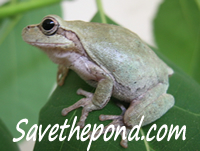 |
 |
|
|
This page only pertains to temperate pond frogs and toads.
Last Updated: 7/1/10
Introduction
Sexing
Breeding
Egg Care
Raising Tadpoles
Links
I free wrote this page (which means I just wrote with no reference).
This page is about the common frogs and toads found in the Eastern US that live in outdoor ponds. It does not attempt to sex all species of frogs or cover tropical or aquarium frogs at all. Sorry if that is what you were looking for!
I get a number of questions about sexing frogs and toads and raising tadpoles. This page is an attempt to put together the information found at various places on my web site.
Each species of frog and toad is a bit different in how they are sexed. In general, for most species, females are the larger one. There are some exceptions such as bullfrogs where the males are larger. In general, males are the more colorful of the two sexes. In general, only the males call (make a lot of noise). Species can be identified by their calls. If found amplexing (mating), the animal on the very top will be male. The one under him may not always be female however as males will amplex with not only females of their species but other males and even males or females of other species. I once found a male wood frog squeezing a male green frog really hard and tried to separate them. I've also found multiple male wood frogs trying to amplex a single female, sometimes in large piles. If you see eggs come out of an amphibian, you can know for sure that that one is female.
Most species of frogs and toads spawn (lay eggs) in the spring. Some species breed like mad for only a few weeks each year while others breed throughout the warm months. There is a lot of variation. During spawning, the male will grab on to the female which is called amplexing. He will squeeze hard, partly to help her get the eggs out but also to stake his claim to her and keep the other males away. Almost all frogs and toads spawn in water whether or not they normally live there. As the female squeezes out her eggs, the male(s) will release sperm. The sperm swims in the water to the eggs to fertilize them. Most batches of eggs are about 80 to 90 percent fertilized. After laying her eggs, the female normally leaves the water (unless she is an aquatic species). Toads lay strings of eggs while frogs lay round globs.
Once fertilized, the eggs absorb water and swell up to much larger than their expelled size. If the water is clean enough, the eggs develop well. In dirtier water (or sometimes for other reasons), the eggs may be attacked by fungus. Fungused eggs will turn white. Algae may also grow on some eggs, mostly the external portions of the eggs. The inner eggs start out clear and gradually turn black in the center which is the developing embryo. Once it is large enough, the embryo can be seen spinning around in the eggs.
In some cases, a person may wish to relocate frog or toad eggs to another pond or even an indoor aquarium. The eggs should be scooped up with a bucket from underneath for the least amount of damage.
See the tadpole page.

|
|
Return to the main amphibian page.
See the master index for the amphibian pages.

|

|
E-mail RobynCopyright © 1997-2025 Robyn Rhudy |

|
 |